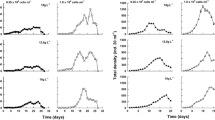Abstract
Two young ponds of known age were investigated and their populations of rotifers and other organisms compared. The earliest colonisers appeared after a few days and included the rotifers Keratella valga (Ehrb.) and Brachionus urceolaris Müller, the cladoceran Daphnia obtusa Kurz and cyclopoid copepods. The rotifers quickly produced males and resting eggs, as well as large numbers of parthenogenetic females. These herbivorous species were followed by an omnivorous Asplanchna species. These species continued to flourish in the ponds several years after digging, in spite of the presence of additional species, although their season of occurrence changed. The greater growth of macrophytes in one pond may account for the greater variety of species in this community.
Similar content being viewed by others
References
Pontin, A. J. & R. M. Pontin, 1980. Bullhousen Pond, Bisley, 1979. Surrey Trust for Nat. Conserv. Newsletter 55: 8–9.
Williams, D. D., 1987. The Ecology of Temporary Waters. Croom Helm, Beckenham & N. S. Wales, 205 pp.
Author information
Authors and Affiliations
Rights and permissions
About this article
Cite this article
Pontin, R.M. Opportunist rotifers: colonising species of young ponds in Surrey, England. Hydrobiologia 186, 229–234 (1989). https://doi.org/10.1007/BF00048917
Issue Date:
DOI: https://doi.org/10.1007/BF00048917




